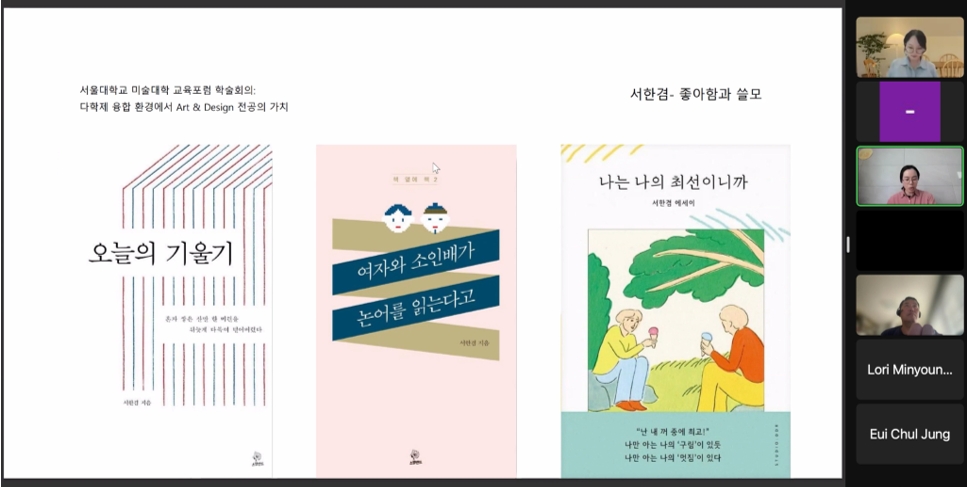On January 19th, Seoul National University’s College of Fine Arts hosted an academic conference that brought together experts–those who had previously pursued degrees in the arts–to share their wisdom and experiences forging their diverse careers. The common thread linking all of the guest speakers was that each individual had pursued multiple academic disciplines during their higher education. For some, that meant double-majoring in the arts, while for others, that meant achieving degrees entirely outside of the artistic realm.
In our current academic landscape, there is increasing recognition of the merit in pursuing multidisciplinary convergence in the approach to education. The perception that there must be a singular and straightforward path to becoming an artist or one who gets to utilize their artistic prowess has long been shattered. If so, what exactly are the options available to students with an inclination towards the arts? To answer that very question, the guest speakers of the conference introduced the student body to the wealth of career opportunities for those currently studying or intending to study the arts. In doing so, they effectively demonstrated the profound value of education in art and design, with its capability to create bottomless potential when interwoven with other academic disciplines.
Designing for Mixed Reality

Dong Yoon Park on his multidisciplinary background in engineering and graphic design
The first guest speaker and keynote lecturer of the conference was Dong Yoon Park, a principal UX designer at Meta’s Reality Labs. Though now a veteran of the design world, with years of experience under his belt, Park originally began his career as a software engineer at Samsung after completing his bachelor’s degree in electrical engineering. While working with graphical user interfaces, he realized that, rather than programming, he was much more interested in the presentation of the graphics on screen. Quitting his job, he embarked on his journey in graphic design at Samsung Art and Design Institute (SADI) and later received his master’s degree in design and technology at Parsons School of Design.
Harnessing his expertise and mind as an engineer, Park has since immersed himself in the world of mixed reality. His prior experience as a principal UX designer with Microsoft’s HoloLens–a take on augmented reality–involves working on a plethora of projects relevant to a vast number of fields. These projects include mission planning for space, flight planning for commercial planes, designing the step-by-step process for large-scale performance arts, and providing medical students with “hands-on” experience.
Park also stated that he initially began his career as a graphic designer with the expectation that his multidisciplinary background would be a unique one. Ironically, he soon learned that coming across those who have exclusively studied the arts is what is truly rare. Graphic designers have the most unimaginably diverse roots, with degrees ranging from engineering and computer science to architecture, psychology, and education. It seems that this heterogeneity is precisely the source of all their innovation.
Art, Writing, and Writing About Art

Hangyeom Seo on her work as both an artist and a writer, influenced by her degrees in philosophy and painting
Another remarkable guest speaker of the conference was Hangyeom Seo, an alumna who studied philosophy and painting during her time at SNU. She has since built a bountiful decade-long career as an artist and also works as an author. According to Seo, pursuing multiple academic disciplines was not a common practice when she was at university. In fact, during her initial attempt to minor in painting, she was the only student present for the practical examination. When rejected, she did not relent but prepared her portfolio and applied once more, later, succeeding in achieving a minor and a master’s degree in painting.
Seo stated that, in retrospect, her choice of studies in the humanities and the fine arts was born out of a love for and interest in the two. Nonetheless, though a believer in the idea that once one master’s their craft, the recognition and monetary rewards eventually follow, Seo still advises students today to choose one major that is well-received and deemed immediately “useful” by society and another that they truly love. That way, they may be undeterred by life’s practical limitations in their creative pursuits.
Seo’s recent endeavors have been where her experiences in art and philosophy most evidently converge, as she produces artist statements, prefaces for exhibitions, and other pieces of writing on artworks. In the case of the prefaces, a singular page that captures the intended message and essence of an exhibition takes her “anywhere between three days to three months.” Before putting the pen on paper, Seo follows a meticulous procedure of collecting the captions corresponding to the art pieces of an exhibition, context that the artist feels is crucial to include in writing, and the artist’s portfolio with all previous bodies of work. She then observes the art for herself if possible and converses lengthily with the artist on their process of preparing their collection. When she finally begins to write, Seo holds one clear objective in her mind: writing simultaneously for an audience that is familiar with the artist’s entire body of work and an audience that is only familiar with the current collection. As expected, the finished preface is one that closely reflects the artist’s wishes.
Dong Yoon Park and Hangyeom Seo are only a fraction of the seasoned professionals that shared their wide range of experiences and career moves after studying art and design. With the assurance provided that the path to becoming a successful creative is a varied and often indirect one, the College of Fine Arts hopes that students may put down their apprehensions and be encouraged to make their own daring pursuits in the artistic sphere.
Written by Hee Seo Lee, SNU English Editor, heeseolee@snu.ac.kr

